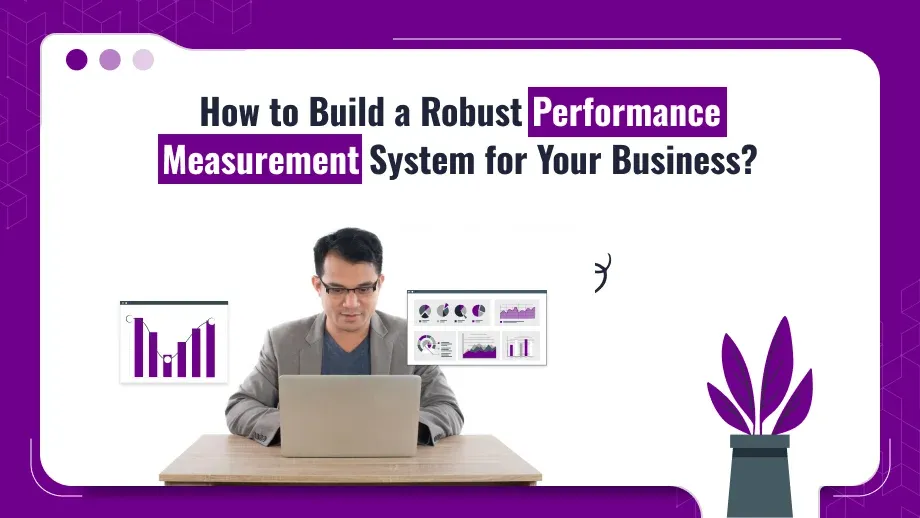
It is that systematic process of measuring, analyzing, and evaluating the results, processes, and efficiency of organizational activities. Organizations utilize it as one of the most crucial tools to understand how well they are reaching their goals, find out areas of improvement, and then make appropriate decisions.
So, at its core, performance measurement has been set up to bridge the strategy with execution so that businesses can track progress and align the work within it to its objectives. This process is more than simple appraisals and usually involves qualitative and quantitative data in summing up an overall view of organizational performance.
Every small and big business requires a strong performance measurement system. In the case of start-ups, it will thereby establish a basis of accountability and growth, while for established enterprises, it ensures scalability and operational efficiency. If a firm does not measure its performance appropriately, it’s most likely to suffer from low efficiency, poorly aligned goals, and misuse of resources.
Important Benefits of Performance Measurement
- Better Decision Making: Data-driven insights facilitate businesses in better strategic decision making.
- Goal Alignment: An excellent performance measure assures the fact that all teams and individuals are working in line with a common vision.
- Employee Engagement: Employees work effectively and feel valued only when their efforts are measured and appreciated.
- Organizational Growth: Sustainable growth is ensured through continuous assessment and improvement.
Performance measurement is not about numbers only but rather understanding what the number is telling. With getting the right tools and techniques to meet their needs, businesses unlock new opportunities to drive success.
Why Do Your Business Needs a Performance Measurement System?
A performance measurement system is actually at the heart of competitiveness for businesses in today’s dynamic market. It effectively provides organizations with a structured way through which to conduct analyses of organizational activities and outcomes, thus ensuring that resources are used effectively and goals reached.
Here’s why every business needs a performance measurement system:
1. Align Business Objectives
A well-thought-through performance measurement system will always steer all functions, groups, and individuals in an organization towards the ultimate goals of an organization. Often, misaligned objectives create inefficiencies and waste resources. In this way, businesses are able to create unity and direction by clearly defining and measuring performance metrics.
2. Better Decision Making
They can only make the usage of data-based strategies hence have expensive errors in intuitive decisions. Performance measurement indeed offers some factual insights, which allow the leaders to learn the strengths, weaknesses, and opportunities. Complex performance measurement tools like HRMS & payroll software offer real-time data visualization to accelerate speed and accuracy in decision-making.
3. Increase Efficiency
Efficiency is always the foundation of the success of an organization. A performance measurement system points out bottlenecks, areas of underperformance, and inefficiency. For example, performance measurement techniques may reveal pockets of inefficiency in workflow or resource usage by teams and pinpoint necessary improvement actions.
4. Improve Employee Engagement
Employees give good performance whenever the efforts are recognized and appreciated. Equal measurement of contribution is assured by a transparent performance measurement system. Such measurements help employees to know their impact, thus supporting their morale and sense of belonging.
5. Compliance and Accountability
Enterprises in regulated businesses have to be extremely compliant. Documentation of performance management goes beyond tracking the progress made but also ensures that organizations achieve compliance. Such compliance is what will instill the necessary trust with stakeholders and minimize risks.
Explore our performance measurement solutions now!
Discover the power of data-driven decisions.
Implementing a Performance Measurement System Challenges
While there are various benefits associated with a performance measurement system, its implementation is never an easy affair. Organizations often face:
- Vague Objectives : Ambiguity in goals prevents effective measurement.
- Resistance to Change: Employees resist new tools or techniques.
- Too Much Data: Management of too much data with inadequate tools leads to confusion.
Overcoming these issues requires a clear roadmap, employee buy-in, and reliable tools. A solid foundation ensures the system’s success and the service’s longevity.
Types of Performance Measurement Systems
Businesses have varied requirements, and an appropriate performance measurement system should be chosen. Here are some of the most common forms:
1. Balanced Scorecard
The balanced scorecard is a management tool that measures performance from four different perspectives: the financial, customer, internal processes, and learning & growth. Its use helps in having an overview of performance comprehensively, relative to the traditional financial metrics, with inclusion of qualitative aspects, like employee development and customer satisfaction.
2. KPIs (Key Performance Indicators)
KPIs are specific, measurable measures that reflect critical success factors. In the example of a sales department, some of these things can be revenue growth, lead conversion rates, or acquisition costs for a customer. OKRs provide a very focused approach toward performance measurement.
3. OKRs (Objectives and Key Results)
OKRs are designed to align the individual and team objectives along with the organizational goals. This system highlights measurable outcomes such that efforts are directed toward impactful results. OKRs are especially useful for tracking progress on ambitious long-term goals.
4. Benchmarking
Benchmarking is a process of comparison of an organization’s performance metrics against any industry standard or competitor. This approach helps businesses realize gaps, set realistic goals, and adopt best practices.
5. 360-Degree Feedback
This system collects feedback from sources such as managers, peers, subordinates, and customers. Since it provides a comprehensive view of performance, 360-degree feedback ensures accountability and continuous improvement.
Performance Measurement Tools and Techniques
Proper performance measurement relies on the appropriate tools and techniques. There are some methods of performance measurement that must suit the goals and availability of data for a business to apply.
Common Performance Measurement Tools:
- HRMS & Payroll Software: Tracks the performance and attendance of employees and compliance.
- Dashboards: Provide real-time information on key metrics to allow quick decisions.
- Survey Tools: Collect qualitative data from employees, customers, and stakeholders.
- Analytics Platforms: Analyze Trends and suggest future performance based on historical data.
- Project Management Tools: Project timelines can be tracked along with team productivity and resource allocation.
- Quantitative Analysis: Numerical data of revenue figures or growth in sales is used for measurement.
- Qualitative Analysis: It focuses on subjective factors such as employee satisfaction or customer loyalty.
- Comparative Analysis: It is compared with the peers or industry leaders to identify gaps.
- Goal-Based Measurement: The metrics are to be directly correlated with organizational objectives.
- Trend Analysis: The data is analyzed with time to identify patterns and hence predict outcomes of the future.
- A selection of the right blend of tools and techniques assures a well-rounded and balanced measurement framework.
This expanded content provides a detailed breakdown of the sections, integrating keywords seamlessly while keeping the information informative and actionable. Let me know if you’d like further expansions or additional sections!
Role of HR in Performance Measurement
The role of HR in performance management is pivotal to the success of any performance measurement system. HR acts as an interface between the goals that are to be achieved at a large scale and the contribution an individual employee can make. The company’s larger vision is going to be met when every individual employee knows his or her role through the designs of systems made within the organization, considering the views of the company and how they will keep it just and transparent.
Key Responsibilities of HR in Performance Measurement:
-
Building Metrics and Standards:
HR is a member of the leadership team to identify key performance indicators (KPIs) and other metrics that must align with the organizational objectives. These metrics must be SMART, i.e., specific, measurable, achievable, relevant, and time-bound.
-
Readying the Organization with Performance Tools:
It ranges from taking on HRMS & payroll software to custom dashboards, where HR plays a central role to equip the organization with the right performance management tool that make the phases of data collection, analysis, and reporting smooth.
-
Employee Training and Support
For the performance measurement methods to function effectively, HR needs to train employees appropriately to use the system. This includes training them on metrics that are going to be measured, how their performance will be appraised, and how they contribute toward organizations’ success.
Performance reviews are one of the bases of effective management. HR ensures that performance reviews are fair by using reliable data gathered through performance measurement techniques and tools. These shall comprise individual assessment as well as team-level evaluation.
-
Providing Feedback and Opportunities for Development:
HR utilizes knowledge of methods of measuring performance to provide good feedback. In addition, HR provides an opportunity for professional development by offering training, mentorship, and upskilling opportunities.
-
Compliance and Fair Practices:
In comprehensive performance management documentation, HR ensures that every evaluation and review is fair, easy, and according to labor law. In this manner, HR manages fairness so that employees’ trust and motivation are maintained.
-
Driving Continuous Improvement:
HR analyzes data trends and identifies areas for improvement. At a more practical level, in leveraging performance measurement, HR can propose the offerings that increase productivity, boost employee satisfaction, and stimulate organizational growth.
-
Importance of HR in Performance Models
Involvement also ensures that the performance measurement system is not only aligned with business objectives but also takes into account the welfare of an employee. Such a system creating balance between organizational demands and individual aspirations induces a culture of growth, responsibility, and collaboration.
-
Building a Comprehensive Performance Model
A performance model is a template applied for gauging and managing organizational performance. It organizes the assessment of inputs, processes, outputs, and outcomes. An ideal performance model calls for integrating various components to assess the situation appropriately and continually improve the performance.
Steps for Creating a Strong Performance Measurement System
A structured approach has to be taken while developing a robust performance measurement system. Every step counts while ensuring its effectiveness and relevance. Here is the step-by-step guide:
1. Clearly Define Objectives:
Define what it is that you wish to achieve. Specific and measurable, while showing alignment with your organization’s vision. For instance, it may be improving the rate of customer retention up by 20% in the following year, or increased employee productivity through simplified workflows.
2. Performance Metrics Identify:
Identify metrics related to the objectives and add insightful meaning. For example, if one aims to boost productivity then the metrics can be output per employee, completion rates of projects, or customer satisfaction scores. They should ideally strike a balance between quantitative and qualitative measures.
3. Select the Right Tools:
Performance measurement software, such as sophisticated project management technologies and dashboards for data visualization, are also utilized to track and measure it.
Data collection by these tools is also guaranteed not to be erroneous.
4. Obtain Relevant Data:
Data from any source should be authentic. This includes gathering data in the internal databases, employee surveys, customer feedback, or even third party benchmarks.
5. Analysis of Results:
The analytical techniques-applied to the data-include trend analysis, comparative evaluation, and benchmarking. In this way, results may pop out concerning areas of strength, weakness, or opportunity.
6. Enact Changes:
Improvements in performance can be identified based on the analysis. This can involve redesigning processes, reallocation of resources, or more employee training.
7. Review and Refine:
Performance measurement is a continuous process. Review regularly the effectiveness of the system and enhance it, where necessary. This will keep the system relevant and aligned to the changing needs of business.
Conclusion
Issues involved in creating a performance measurement system are in the form of resistance to change, data overload, or even unclear objectives. The challenges will be overcome by creating a culture of openness, providing training, and clear expectations.
Building a strong performance measurement system would be the way towards sustainable business success. The proper application of the right techniques and models through tools for measuring performance can be applied towards tracking progress, improving efficiency, and maintaining an environment of continuous improvement within organizations.
Basically, the role of HR puts itself at the very heart of performance management-to ensure that systems used for performance management are fair, transparent, and support the organizational goals. A good system can actually help the business, but it should also empower employees as it recognizes the effort put into them and makes chances to grow.





